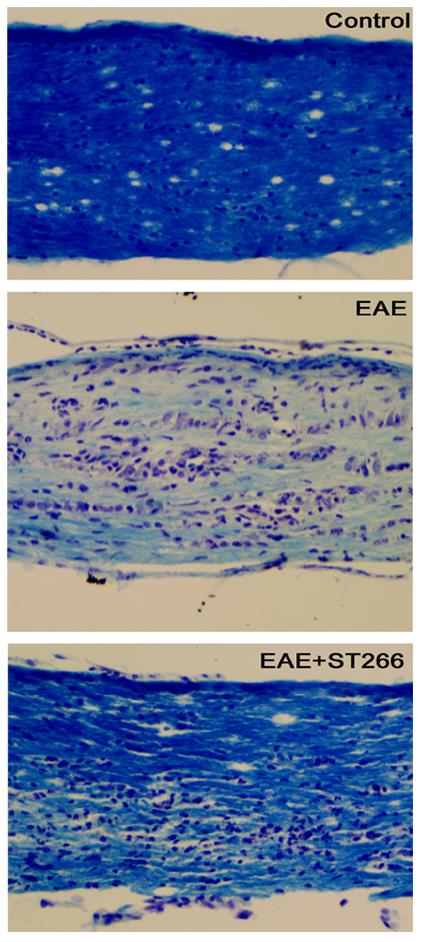Anti-cell death agent a potential treatment for vision loss associated with MS

This image shows myelin (blue) in the optic nerve of a normal mouse (top), a mouse with optic neuritis (middle), and an optic neuritis mouse treated with ST266 (bottom). Credit: Ken Shindler, MD, PhD, Perelman School of Medicine, University of Pennsylvania
The team demonstrated the therapeutic potential of the agent, called ST266, for treating optic neuritis, inflammation that damages the optic nerve and is a common presenting feature of MS. About half of patients diagnosed with MS experience optic neuritis, which can cause mild to moderate permanent loss of vision, but rarely complete blindness. ST266 is a solution of molecules that stimulate paracrine signaling. This is one way in which cells “talk” to each other: One cell produces a chemical signal that induces changes in nearby cells.
“In this case, the idea is that the many factors in ST266 not only bind to cell receptors and cause changes within the cells they bind to, but those cells then alter their own secretions and provide additional signals to other neighboring cells, thus propagating an effect from a relatively small amount of protein present in the therapy itself,” Shindler said. “To the best of our knowledge, this study demonstrates, for the first time, the ability to treat the optic nerve via the intranasal route of administration.”
When ST266 was given to the MS mice via their nose, it reached the central nervous system within 30 minutes and was detected at higher concentrations in parts of the eye and optic nerve compared to other areas of the brain. These findings demonstrated that this type of delivery can target tissues of the eye, which is easier, less painful, and less invasive than injecting medication directly into the eye.
In mice with optic neuritis, the team showed that early treatment with ST266 prevented damage and dysfunction, marked by significantly reduced loss of optic nerve cells, and suppression of inflammatory cell infiltration into the optic nerve. This in turn was associated with limitation of the degree of demyelination caused by MS- related optic neuritis. However, “it's not known if these effects are independent effects of the therapy or interdependent effects,” Shindler said.
Treatment of later-stage optic neuritis in the MS mice showed similar results, resulting in improved visual function compared to untreated groups. The data suggest that ST266 helps promote optic neuron survival by potentially activating multiple pathways, including those that prevent cell death.
“These results are particularly important as the preservation of retinal cells is a significant factor when treating optic neuritis,” Shindler said. “There is an increased need for combination treatment options that are able to prevent nerve-cell axon loss for patients with optic neuritis.”
Currently, the only acute treatment for MS-related optic neuritis is IV steroids, which only hasten whatever amount of visual recovery will occur even without treatment. Steroids do not prevent nerve damage or permanent vision loss. “ST266's ability to preserve vision in the preclinical model and reduce neuronal loss would be a huge advance if it translates to human patients,” Shindler said.
The study also has implications beyond MS-related optic problems. “We also showed an effect on cultured neurons, suggesting that effects may translate to other optic nerve diseases, as well as other brain neurodegenerative diseases,” Shindler said.
###
Editor's Note: Dr. Shindler has served as a scientific advisory board member and received consulting fees from Noveome (formerly Stemnion, Inc.). In addition, Noveome has provided unrestricted funds to Penn to support research in Dr. Shindler's laboratory.
Penn Medicine is one of the world's leading academic medical centers, dedicated to the related missions of medical education, biomedical research, and excellence in patient care. Penn Medicine consists of the Raymond and Ruth Perelman School of Medicine at the University of Pennsylvania (founded in 1765 as the nation's first medical school) and the University of Pennsylvania Health System, which together form a $5.3 billion enterprise.
The Perelman School of Medicine has been ranked among the top five medical schools in the United States for the past 18 years, according to U.S. News & World Report's survey of research-oriented medical schools. The School is consistently among the nation's top recipients of funding from the National Institutes of Health, with $373 million awarded in the 2015 fiscal year.
The University of Pennsylvania Health System's patient care facilities include: The Hospital of the University of Pennsylvania and Penn Presbyterian Medical Center — which are recognized as one of the nation's top “Honor Roll” hospitals by U.S. News & World Report — Chester County Hospital; Lancaster General Health; Penn Wissahickon Hospice; and Pennsylvania Hospital — the nation's first hospital, founded in 1751. Additional affiliated inpatient care facilities and services throughout the Philadelphia region include Chestnut Hill Hospital and Good Shepherd Penn Partners, a partnership between Good Shepherd Rehabilitation Network and Penn Medicine.
Penn Medicine is committed to improving lives and health through a variety of community-based programs and activities. In fiscal year 2015, Penn Medicine provided $253.3 million to benefit our community.
Media Contact
All latest news from the category: Health and Medicine
This subject area encompasses research and studies in the field of human medicine.
Among the wide-ranging list of topics covered here are anesthesiology, anatomy, surgery, human genetics, hygiene and environmental medicine, internal medicine, neurology, pharmacology, physiology, urology and dental medicine.
Newest articles

Properties of new materials for microchips
… can now be measured well. Reseachers of Delft University of Technology demonstrated measuring performance properties of ultrathin silicon membranes. Making ever smaller and more powerful chips requires new ultrathin…

Floating solar’s potential
… to support sustainable development by addressing climate, water, and energy goals holistically. A new study published this week in Nature Energy raises the potential for floating solar photovoltaics (FPV)…

Skyrmions move at record speeds
… a step towards the computing of the future. An international research team led by scientists from the CNRS1 has discovered that the magnetic nanobubbles2 known as skyrmions can be…





















